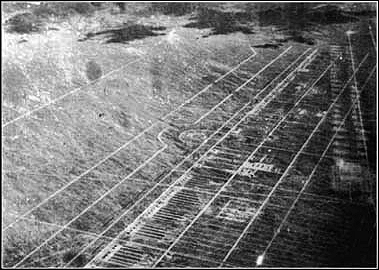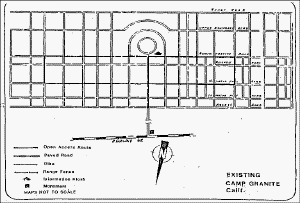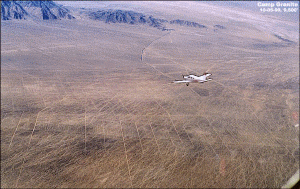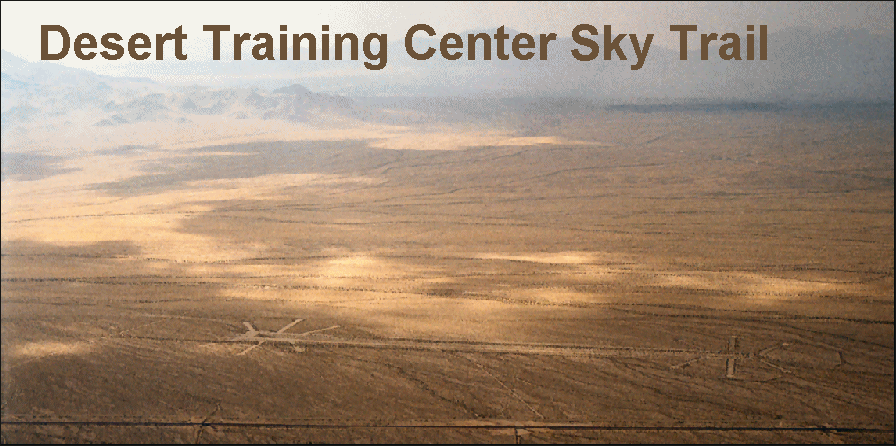Camp Granite
 Camp Granite was established in the spring and
summer of 1943. The original camp was closer to the
highway but, because of flooding, was moved closer
to the mountains. The date of this move is unknown.
The 90th and 104th Infantry Divisions were both
assigned to Camp Granite, at different times. Thre camp was flooded,
and the 90th Division moved to higher ground when they arrived. [John Lynch:
E-mail June 16, 1999]
Camp Granite was established in the spring and
summer of 1943. The original camp was closer to the
highway but, because of flooding, was moved closer
to the mountains. The date of this move is unknown.
The 90th and 104th Infantry Divisions were both
assigned to Camp Granite, at different times. Thre camp was flooded,
and the 90th Division moved to higher ground when they arrived. [John Lynch:
E-mail June 16, 1999]
Among
the smaller units known to have been stationed at
Camp Granite were the 76th Field Artillery Brigade
and the 413th Infantry Regiment. The 76th Field
Artillery Brigade, in fact, was stationed at Camp
Granite prior to the completion of the camp and may have been there to
assist in its construction. During
the XV Corps occupation of the DTC/CAMA (July-November 1943), the headquarters of the XV Corps'
artillery was at Camp Granite.
Facilities constructed at the camp include 40 shower
buildings, 157 latrines, 191 pyramidal wooden tent
frames, and one 50,000-gallon water tank.
There
were a total of nine ranges south of the camp, all of
which faced into the Granite Mountains. The ranges
were used for artillery, rifle and pistol, regimental,
towed target (57- and 105-mm), and antiaircraft (.30-caliber
and .50-caliber) weapons.
 Camp Granite is located south across California Highway 62 from Camp Iron Mountain, near the
base of the Granite Mountains. The MWD aqueduct
was located northeast of camp and supplied it with
water. The camp was located near the
Palen Pass
area to the south, where several large maneuvers
Camp Granite is located south across California Highway 62 from Camp Iron Mountain, near the
base of the Granite Mountains. The MWD aqueduct
was located northeast of camp and supplied it with
water. The camp was located near the
Palen Pass
area to the south, where several large maneuvers
 took place.
took place.
Current Condition
The remains of numerous rock-lined roadways can still be discerned, as can
several rock insignias. Reports of ordnance have been made
south of the camp area, indicating the presence of
artillery ranges in the vicinity. The majority of the eastern portion of
the camp has been washed away.
The western portion of the camp, particularly that
lying at the foot of the Granite Mountains, is extremely
well preserved. Numerous rock-lined walkways
can be found in this portion of the camp, as can
unit insignias, several of which have been roped off. Access to this portion of the
camp is easy, although the road leading from the
highway is extremely sandy.
484th Quartermaster
Battalion
Freda
A camp, complete with rock-lined walkways and roads and the insignia of the
484th Quartermaster Battalion, exists west of the Freda railroad siding,
immediately south of the MWD aqueduct and northwest of Camp Granite. There
also appear to be several pieces of water tanks, as well as other
miscellaneous metal. The camp is well preserved and should be
considered eligible for listing in the NRHP. It can be accessed from
the MWD aqueduct road extending west from California Highway 62, immediately
west of where the highway bends at Freda. The camp is approximately
0.25 miles down the road, to the south. Further archival research
should be performed on this camp. It is expected that the camp
represents a historically important aspect of the DTC/C-AMA, and it is
likely eligible for listing in the NRHP. The site is in good condition
and retains sufficient integrity.
Palen Pass
The site of the largest maneuvers during the life of the DTC/C-AMA, Palen
Pass received heavy impacts from the army. Fortifications were
constructed throughout the pass, as one unit would "defend" the area from
another. These fortifications consisted of gun emplacements,
barbed-wire entanglements, bunkers, minefields, and foxholes. Several
maneuvers were held in the area. In addition, each unit that came to defend Palen Pass erected its own defenses by building on what had already been
constructed by previous units. Vestiges of maneuvers can also be found
in the valley east of the pass, in the form of bomb craters, cartridge
cases, concertina
wire, and various refuse. Palen Pass can be accessed from the
Arlington Mine Road, east from California Highway 177. This road is
very sandy in places and should be traveled only in a four-wheel drive
vehicle.
Perhaps the largest maneuver to take place was the first mock battle of
Palen Pass. The battle was partly conducted for the benefit of
visiting dignitaries, including several state governors. One of the
participants in the battle, Sgt. Joe Delgado, recalled the action several
decades later:

First came the airplanes and strafed hell out of it .
Then the artillery shells began to cover the ground,
next came tanks rumbling into the pass blasting
away and finally streams of troops. There was so
much dust and smoke up there you wouldn't think
anything could be alive for miles. But when we
stopped, and the smoke began to clear, someone
shouted, "Hey look up there, what's that moving?"
And just like nothing at all had been going on, this
old dusty prospector and his burro, looking like
something from the last century, came walking
through all that smoke and dust and debris paying
no attention at all to any of us or all the live
ammunition we'd blasted that pass with [as quoted
in Pew 1985:29].
On August 20, 1943, the 85th Division was treated to a tremendous fire
power demonstration of aircraft and infantry. The demo included P-38
fighters that attacked ground targets. Then the entire 2nd Battalion of the
339th Regiment massed along the firing line and fired all the weapons at
once, including rifles, machine guns and mortars.
Desert field exercises were carried out by battalion and involved a meeting
engagement with the enemy, an overnight bivouac and an early morning attack.
These were held across the valley from Camp Coxcomb, just before the Palen
Pass, which ran between the Little Maria and Palen Mountains
During October 25 to November 13, 1943, the 15th Corps maneuvers were
carried out in the Palen Pass area east of Camp Coxcomb. This included the
81st and the 79th Infantry Divisions, the 15th Mechanized Cavalry, 182nd and
119th Field Artillery Groups, 3rd Field Artillery Observation Battalion ,
185th Tank Destroyer Battalion and 2 anti-aircraft groups.
The army recognized that practically the
entire maneuver area had been used for live-fire
exercises, and that clearing it [of unexploded ordnance] was nearly impossible.
The Palen Pass maneuver area was left as is, and only marked with signs
(Blake 1987: 30).
